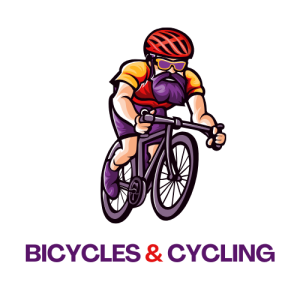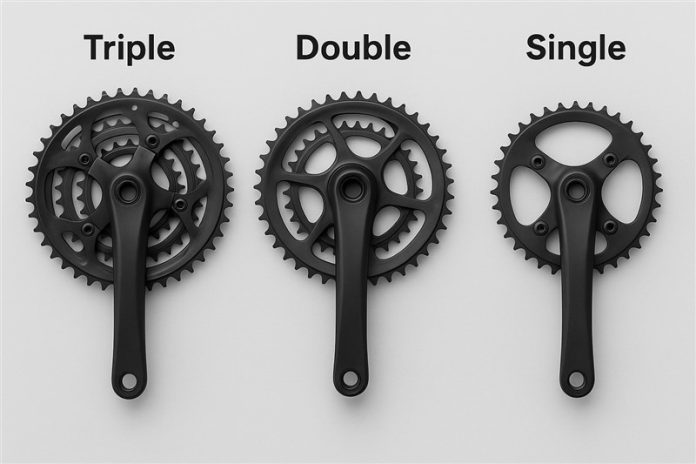Choosing the best gear ratios for long-distance cycling is one of the most important decisions you can make when preparing for endurance events, multi-day tours, or ultra-distance rides. The right gearing setup determines whether you can comfortably climb steep hills, maintain efficient cruising speeds, and avoid unnecessary strain over hundreds of kilometres.
This guide explores the different drivetrain setups available—triple, double, and single (1x) chainsets, as well as Rohloff hubs and Pinion gearboxes—to help you choose the most suitable gear range for your style of riding.
Why Gear Ratios Matter for Endurance Cycling
Efficiency Over Time
On long rides, energy conservation is critical. Gear ratios allow you to maintain a steady cadence and power output, which reduces fatigue. Too high a gear on a climb can push you into the red zone; too low a gear on flats can make you spin inefficiently.
Terrain Variability
Long-distance cycling often involves varied terrain—mountain passes, rolling countryside, and headwinds. A wide gear range ensures you have a low enough gear for climbs and a high enough gear for descents or tailwinds.
Mechanical Reliability
Over thousands of pedal strokes, drivetrain efficiency and reliability are vital. Fewer mechanical issues mean more consistent riding and less roadside repair.
Understanding Gear Ratios
Gear ratios are determined by the number of teeth on the chainring(s) and the cassette sprockets. A “lower” gear ratio makes pedalling easier at slower speeds (useful for climbs), while a “higher” ratio allows faster speeds with harder pedalling (useful on flats and descents).
Gear Inches
A common way of comparing setups is gear inches, which represents how far the bike travels with one pedal revolution. Touring riders often aim for a low gear under 20 gear inches for steep climbs and a high gear above 100 gear inches for fast sections.
Triple Chainsets: Maximum Range
What They Are
Triple chainsets feature three front chainrings (commonly 50/39/30T or 48/36/26T) paired with a wide-range cassette.
Advantages
- Huge range: Perfect for hilly routes and loaded touring.
- Very low climbing gears: Helps when carrying panniers or bikepacking setups.
- Fine gear spacing: More options to find the “just right” cadence.
Disadvantages
- Weight & complexity: More parts and shifting required.
- Overlap: Many duplicated ratios across the range.
Best For
Loaded touring, riders who want maximum flexibility, or routes with extreme climbs.
Double Chainsets: Compact and Versatile
What They Are
Compact doubles usually run 50/34T or 48/32T paired with a modern wide-range cassette (e.g., 11–34).
Advantages
- Simpler than triples: Two rings keep shifting straightforward.
- Good all-round range: With modern cassettes, still provides excellent climbing gears.
- Lighter and more efficient.
Disadvantages
- Slightly less low-end: May not be as forgiving for very steep gradients with luggage.
- Bigger jumps: Between gears compared to triples.
Best For
Audax riders, randonneurs, and long-distance cyclists who want efficiency with fewer shifting decisions.
Single Chainsets (1x Drivetrains): Modern Simplicity
What They Are
A 1x drivetrain has a single chainring up front (typically 38–46T) paired with a very wide cassette, often 10–50T or 10–52T.
Advantages
- Simple shifting: Only one shifter, no front derailleur.
- Lightweight: Fewer parts, cleaner design.
- Less to go wrong: Reliable in muddy or dusty conditions.
Disadvantages
- Wider gear jumps: Can break rhythm on long road rides.
- Limited top or bottom end: Hard to cover both extremes perfectly.
- Less efficient chainline.
Best For
Gravel riders, bikepackers who value simplicity, and cyclists who prioritise reliability over perfectly smooth cadence.
Rohloff Hubs: Proven Touring Reliability
What They Are
The Rohloff Speedhub is a 14-speed internally geared hub with a range equivalent to a 526% cassette.
Advantages
- Huge gear range: Covers almost all use cases.
- Sealed system: Weatherproof, extremely reliable.
- Even spacing: Each gear is 13.6% apart.
- Low maintenance: Oil change every 5,000 km.
Disadvantages
- Weight: Heavier than standard derailleur systems.
- Cost: High upfront investment (£1,000+).
- Drag: Slight efficiency loss compared to top-end derailleurs.
Best For
Expedition touring, ultra-distance riders prioritising reliability, and anyone cycling in remote locations.
Pinion Gearboxes: The Future of Drivetrains
What They Are
Pinion gearboxes are crank-mounted internal gear systems with up to 18 evenly spaced gears and a range of over 600%.
Advantages
- Massive range: More than enough for any terrain.
- Durability: Enclosed system with long service intervals.
- Balance: Central weight distribution.
Disadvantages
- Cost & availability: Still niche and expensive.
- Frame compatibility: Requires specific gearbox-compatible frames.
- Slight drag: Not quite as efficient as traditional systems.
Best For
Riders investing in a bike for life, adventurers covering extreme distances, and those wanting cutting-edge tech.
Comparison Table: Gear Options for Long-Distance Cycling
| System | Range (%) | Pros | Cons | Best For |
|---|---|---|---|---|
| Triple Chainset | ~600% | Maximum flexibility, very low gears | Heavy, complex | Loaded touring, steep routes |
| Compact Double | ~500% | Efficient, lighter, simpler | Slightly less climbing range | Audax, endurance road |
| 1x Drivetrain | 420–520% | Simple, reliable, light | Big gear jumps, limited extremes | Gravel, bikepacking |
| Rohloff Hub | 526% | Reliable, sealed, low maintenance | Expensive, heavy | Expedition, remote touring |
| Pinion Gearbox | 600%+ | Huge range, durable, centralised | Expensive, special frames | Long-term touring, extreme rides |
Choosing the Right Gear Ratio
When selecting the best setup, consider:
- Terrain: Mountainous or flat?
- Load: Riding light or fully loaded with panniers?
- Distance: Weekend ride or transcontinental trip?
- Maintenance tolerance: Do you prefer easy roadside fixes or long service intervals?
Recommendations
- Audax / Randonneuring: Compact double with 11–34 cassette.
- Loaded Touring: Triple chainset or Rohloff hub.
- Gravel Endurance: 1x with 10–50 cassette.
- Expedition Adventure: Pinion gearbox or Rohloff hub.
Final Thoughts
The best gear ratios for long-distance cycling depend on your goals, terrain, and tolerance for complexity. Riders seeking ultimate flexibility may prefer a triple, while modern endurance cyclists lean toward compact doubles. 1x systems simplify life at the cost of some efficiency, while Rohloff and Pinion offer unmatched reliability and range for those who can justify the investment.
Whatever you choose, aim for a setup that gives you a climbing gear under 20 gear inches and a top gear over 100 gear inches—this balance ensures you’ll be comfortable, efficient, and prepared for any challenge the road throws your way.















